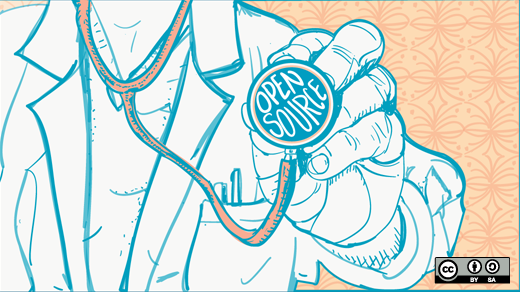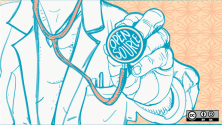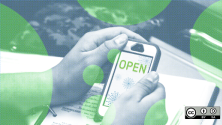How do you introduce a woman whose very life is the epitome of humanitarian efficacy? Judy Gichoya is a Kenyan medical doctor specializing in radiology and an experienced programmer who's accelerating the growth of OpenMRS.
According to its website, "OpenMRS is a software platform and a reference application which enables design of a customized medical records system with no programming knowledge." Judy first got interested in computers in high school, prior to entering medical school she learned to program at a technical college and through online resources on the internet. She enrolled in medical school and earned the extra income she needed to sustain herself by working at a company where she assembled 10 computers a night.
She continued to upgrade her programming skills, initially focusing on Java but later moving to Python, Angular JS, and HTML5. A chance meeting with a developer working on OpenMRS in the United States who visited Kenya and provided training to local people who were interested resulted in her initial involvement with the project. She found his work very inspiring, so once she graduated medical school she got involved with OpenMRS. I recently had a chance to interview her.

It's said that if you want to get something done, you should ask a busy person. How does this explain your involvement in OpenMRS?
I'm not sure "busy" is the right word to explain participation in OpenMRS. Nonetheless, I've always been restless. As a young girl, I would travel to Nairobi, but that's really not how I got involved in OpenMRS.
I went to medical school at Moi University in Eldoret, Kenya. As I entered my clinical years, I was frustrated by the inefficiencies of caring for patients. We were attending to hundreds of HIV-positive patients, and I thought to myself, "There must be a better way of organizing these patients' information to make doctors' lives easier." I then found a group of doctors and geeks working on OpenMRS to try and create the very thing I had imagined. I guess I was at the right place right time. It's now been a decade since I first got involved.
I've participated in OpenMRS as a developer, implementer, and a community member. In the past year, I've focused on OpenMRS evangelism.
How has your passion for open source software helped your desire to address both health care and poverty?
To be honest, I never knew what open source software was. I have been greatly educated now on free versus open source software now, but what I am passionate about are the open source communities—the people who build and use open source software.
I've worked in very needy areas alongside some amazing people, and even with the best software it's the people who make a difference for both health care and tackling poverty. For example, eight years ago I met a young man named Peter in the Kibera slums, the largest slum in Africa. He was working as a helper at a local hospital. My approach for open source software has always been to work with the local people, and I remember helping Peter buy his first computer as a condition for working at the clinic to install OpenMRS. Peter had no IT skills, and so he worked hard to learn as much as he could. The project took longer than I had planned for, and I was frustrated at times thinking of how easy it would be to do everything by myself and be done with it, but that investment paid off in a big way. This remains my first and oldest OpenMRS implementation.
Peter has since left the slum and is almost done with his bachelor's degree in computer science. He surprised me last year by informing me that he had set up a computer school in his village to offer other young people the chance I afforded him. My investments don't always have huge returns like Peter, but the open source helps me focus on what matters most—people. It's easier to do this as a doctor and geek, and even more to work in an area I truly enjoy.
How did OpenMRS get started?
OpenMRS came from a crisis. HIV was a pandemic in East Africa, and the earliest doctors that visited as missionaries saw the suffering of the people from this disease. One of those doctors was Professor Joe Mamlin, a physician from Indiana University who was working in Eldoret. The first system was an excel spreadsheet. It was later changed to Access. At that point Access had a maximum number of rows for the database, but the number of patients and visits was increasing and he needed a system to help organize HIV data. Joe's son Burke, also a doctor and a brilliant computer scientist, was visiting his father and witnessed firsthand the need for a better system. A group of four physician geeks attending the MedInfo 2014 conference in San Francisco during break sketched out the data model for the first OpenMRS.
OpenMRS launched in Kenya and Rwanda and is now used in over 40 countries (with some national implementations of the system). OpenMRS grew by word of mouth—no money was ever invested in any form of advertising. In terms of licensing, we now use the Mozilla Public License for the following reasons:
- Our goal of keeping the platform open without scaring off entrepreneurs or others who might have interest in leveraging the platform for their commercial interests. Part of our mission is to empower people in resource-constrained environments to help build efficient and sustainable solutions to meet the health care needs of their people, which is—in large part—best accomplished through local capacity-building and allowing for the growth of self-sustaining solution such as service-based companies.
- Indemnity for medico-legal issues.
- Allow modules to be licensed separately. While we love to see people making open source modules for OpenMRS, we don't want to prevent people from creating commercial modules if it can help them creating sustainable solutions and improve the care for people in resource-constrained environments.
- Ensure that work on the platform itself is shared.
But we had to make several modifications to MPL 1.1 to meet our needs, meaning we weren't using an official OSI-approved license. When MPL 2.0 came, it presented a great opportunity to migrate to a largely identical license that met our needs and no longer required us to make modifications to the license.
How is sharing data in helping to improve world health? Although OpenMRS has been primarily developed for the poor, do you see implications for the developed world?
New implementations are now at the point of data sharing, but the primary task for OpenMRS was to facilitate data collection. Remember, these are areas with no cell phone coverage, poor connectivity, high costs of hardware, and we are just coming off that era of digitization. The early users were not computer literate, so lots of effort was spent on training and sensitization. Health data saves lives. Examples of good uses of health data are immunization monitoring to ensure complete vaccination, a platform for community health workers with linkage and retention and tools like the notifiable condition detector that help with detection of disease outbreaks like Ebola. This is the potential of health data.
For the developed countries, new initiatives like personalized medicine, FHIR are trying to encourage open innovation in health care. OpenMRS as a platform is easily adaptable to the developed countries. For example, in my institution, the interventional radiology department was keen on tracking outcomes of patients treated for liver cancer and metastatic disease. I repurposed OpenMRS to meet this need that is informing how we care for our patients.
What are your most pressing needs? How can we help?
Unfortunately, building open source is painful and requires a pivot of our thinking. There is no longer a HIV crisis, and to be able to tackle global health requires a difference in thought. We spent the last decade on code with our motto being "Write code, save lives." However, my experience makes me believe that "people before code" is the way to go ahead. Teaming up with some of my friends and close colleagues who have spent the last decade in OpenMRS and feel the same way, we have come together to launch a new generation open source community called LibreHealth that moves health information technology forward. For example, I've been working to build a radiology system for developing countries for the past year, yet we are unable to get developers to help with our work. Under the new structure, we will move development to actual areas where our software is used, providing a better experience for both developers and communities. We will have a stronger education program and ecosystem to support innovation and accelerate actions to tackle global health. We will be merging best practices of two communities working in open source for the next generation EMR system.
We love new members, so you can join us at https://forums.librehealth.io/. We are looking for developers and funders as well as implementers that we can work with. If you care about open source, then you qualify to be part of us.
Reach out to me on email or @judywawira and follow my blog to learn more on what I am working on.






2 Comments